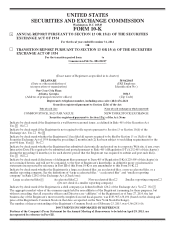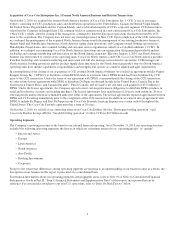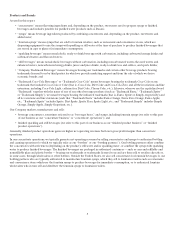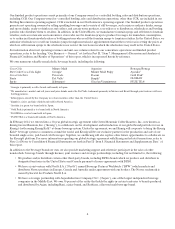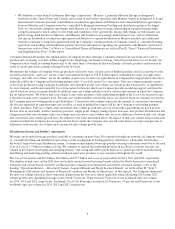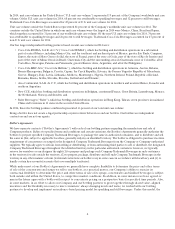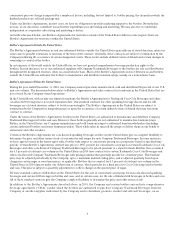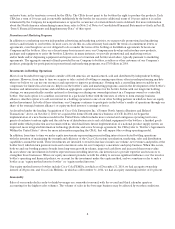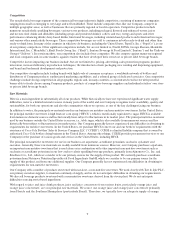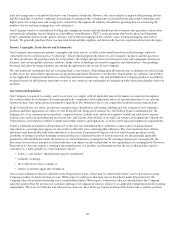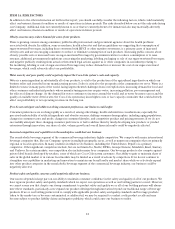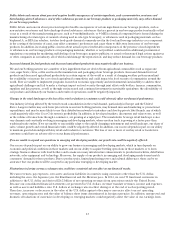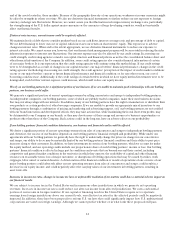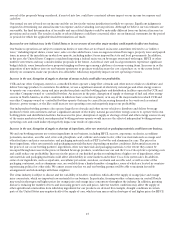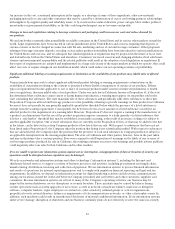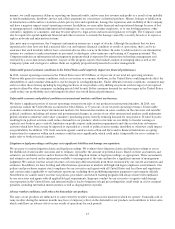Coca Cola 2014 Annual Report Download - page 11
Download and view the complete annual report
Please find page 11 of the 2014 Coca Cola annual report below. You can navigate through the pages in the report by either clicking on the pages listed below, or by using the keyword search tool below to find specific information within the annual report.9
Competition
The nonalcoholic beverage segment of the commercial beverage industry is highly competitive, consisting of numerous companies
ranging from small or emerging to very large and well established. These include companies that, like our Company, compete in
multiple geographic areas, as well as businesses that are primarily regional or local in operation. Competitive products include
numerous nonalcoholic sparkling beverages; various water products, including packaged, flavored and enhanced waters; juices
and nectars; fruit drinks and dilutables (including syrups and powdered drinks); coffees and teas; energy and sports and other
performance-enhancing drinks; dairy-based drinks; functional beverages, including vitamin-based products and relaxation beverages;
and various other nonalcoholic beverages. These competitive beverages are sold to consumers in both ready-to-drink and other than
ready-to-drink form. In many of the countries in which we do business, including the United States, PepsiCo, Inc. (“PepsiCo”), is one
of our primary competitors. Other significant competitors include, but are not limited to, Nestlé, DPSG, Groupe Danone, Mondele
-z
International, Inc. (“Mondele
-z”), Kraft Foods Group, Inc. (“Kraft”), Suntory Beverage & Food Limited (“Suntory”) and the Unilever
Group (“Unilever”). In certain markets, our competition also includes beer companies. We also compete against numerous regional
and local companies and, in some markets, against retailers that have developed their own store or private label beverage brands.
Competitive factors impacting our business include, but are not limited to, pricing, advertising, sales promotion programs, product
innovation, increased efficiency in production techniques, the introduction of new packaging, new vending and dispensing equipment,
and brand and trademark development and protection.
Our competitive strengths include leading brands with high levels of consumer acceptance; a worldwide network of bottlers and
distributors of Company products; sophisticated marketing capabilities; and a talented group of dedicated associates. Our competitive
challenges include strong competition in all geographic regions and, in many countries, a concentrated retail sector with powerful
buyers able to freely choose among Company products, products of competitive beverage suppliers and individual retailers’ own store
or private label beverage brands.
Raw Materials
Water is a main ingredient in substantially all of our products. While historically we have not experienced significant water supply
difficulties, water is a limited natural resource in many parts of the world, and our Company recognizes water availability, quality and
sustainability, for both our operations and also the communities where we operate, as one of the key challenges facing our business.
In addition to water, the principal raw materials used in our business are nutritive and non-nutritive sweeteners. In the United States,
the principal nutritive sweetener is high fructose corn syrup (“HFCS”), which is nutritionally equivalent to sugar. HFCS is available
from numerous domestic sources and has historically been subject to fluctuations in its market price. The principal nutritive sweetener
used by our business outside the United States is sucrose, i.e., table sugar, which is also available from numerous sources and has
historically been subject to fluctuations in its market price. Our Company generally has not experienced any difficulties in obtaining its
requirements for nutritive sweeteners. In the United States, we purchase HFCS to meet our and our bottlers’ requirements with the
assistance of Coca-Cola Bottlers’ Sales & Services Company LLC (“CCBSS”). CCBSS is a limited liability company that is owned by
authorized Coca-Cola bottlers doing business in the United States. Among other things, CCBSS provides procurement services to our
Company for the purchase of various goods and services in the United States, including HFCS.
The principal non-nutritive sweeteners we use in our business are aspartame, acesulfame potassium, saccharin, cyclamate and
sucralose. Generally, these raw materials are readily available from numerous sources. However, our Company purchases aspartame,
an important non-nutritive sweetener that is used alone or in combination with other important non-nutritive sweeteners such as
saccharin or acesulfame potassium in our low- and no-calorie sparkling beverage products, primarily from Ajinomoto Co., Inc. and
SinoSweet Co., Ltd., which we consider to be our primary sources for the supply of this product. We currently purchase acesulfame
potassium from Nutrinova Nutrition Specialties & Food Ingredients GmbH, which we consider to be our primary source for the
supply of this product, and from one additional supplier. Our Company generally has not experienced any difficulties in obtaining its
requirements for non-nutritive sweeteners.
Our Company sells a number of products sweetened with sucralose, a non-nutritive sweetener. We work closely with Tate & Lyle PLC,
our primary sucralose supplier, to maintain continuity of supply, and we do not anticipate difficulties in obtaining our requirements.
We also sell beverage products sweetened with a non-nutritive sweetener derived from the stevia plant. We do not anticipate
difficulties sourcing stevia-based ingredients.
With regard to juice and juice drink products, juice and juice concentrate from various fruits, particularly orange juice and
orange juice concentrate, are our principal raw materials. We source our orange juice and orange juice concentrate primarily
from Florida and the Southern Hemisphere (particularly Brazil). Therefore, we typically have an adequate supply of orange

